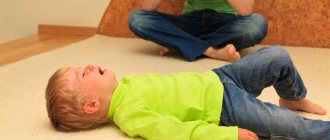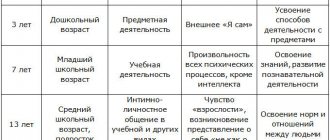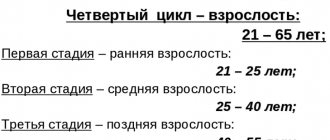Every child tends to be capricious from time to time. Sometimes this happens for obvious reasons: tired, nervous, offended someone, faced injustice. But there are entire periods when uncontrollable and intolerable behavior is not limited to one situation, but continues for several months. Disobedience, hysterics, protests, rude speech, refusal to make contact - the list of problems can be endless.
In this difficult period, it is difficult to find any logical explanation for what is happening. Those who are familiar with psychology know that age-related crises are to blame for everything.
What it is
Childhood crises are transitional stages from one stable (lytic) life period to another, characterized by a holistic change in the child’s personality, caused by the emergence of psychological new formations. To designate them, Vygotsky introduced the term “normative crises of development.”
There are many different approaches to their definition and classification (Vygotsky, Elkonin, Erikson, Leontiev, Bozhovich, etc.). Despite such diversity, they are all very similar and agree on most key points.
Psychology explains them quite simply. All children grow in leaps and bounds, during which, according to research, the brain begins to actively emit impulse waves. Scientists have yet to find out their nature and significance, but at these moments significant changes occur with mental and physical development.
Physical changes
Just yesterday he was crawling, but today he is already clumsily walking. Just yesterday I couldn’t do without outside help, but today I’m tying my shoelaces and trying to make breakfast for myself. Just yesterday my daughter was an angular, clumsy teenager, and today she has turned into a beautiful, mature girl.
Mental changes
Each age-related crisis period is accompanied by neoplasms. At 1 year - this is autonomous speech, motivating ideas, self-image. At 3 years old - primary independence, building more complex relationships, a new level of self-awareness, volitional regulation of activity. At 7 years old - arbitrariness and indirectness of actions, awareness of one’s own experiences, new social roles. At 13 - an exaggerated sense of adulthood. At 17 - professional and personal self-determination.
Why are these surges called crises? Because they represent a difficult transitional state to a new level - both physically and mentally. This process is not easy not only for parents, but most of all for the child himself. He is afraid of the dramatic changes that are happening to his body and worldview. And in response to them he begins to protest, trying to run away and hide from such a development of events. Hence the uncontrollable behavior.
Crisis 12–18 years
“Who am I without the influence of my parents?”
A child’s whole life is a series of different roles: a student or friend, an older brother or sister, an athlete or a musician. In adolescence, the main question arises: “Who am I really?” Before this period, children practically do not criticize their parents and significant adults; they accept all our rules, beliefs and values on faith.
In adolescence, it is important to understand these ideas, roles, move away from parents and collect all ideas about oneself into one holistic identity. Identity is a feeling of one’s own truth, completeness, belonging to the world and other people.
Searching for your identity, the answer to the question: “Who am I?” - and this is the main task of this period.
Under the influence of different people, a child accumulates very contradictory values throughout his life. For example, in the family there is an important value - education. And a child has an important value - friendship. And my friends are the ones who don’t see the value of studying. A teenager is faced with a choice: either “give up” on studying with friends, or, having chosen to study, lose the company of friends. Parents have a hard time during this period precisely because the essence of the crisis itself is leaving the influence of parents. Hence, obvious disobedience, disobedience, arguments, “withdrawal,” slamming doors and other variants of teenage rebellion.
It is important for parents to find a balance between upholding demands that they will not refuse and the new freedom in ideas and actions that the teenager receives. For example, alcohol intoxication - under no circumstances
It is unacceptable. Dot. But your wardrobe - maybe we don’t like it - but it’s yours, decide for yourself. Just try to dress according to the weather, and beauty and style are your prerogatives. The actions of parents largely determine whether a person can become a self-sufficient, stable person, with his own internal principles, or whether he will be constantly dependent on the opinions of first his parents, then his other half, his boss and other significant people.
The crisis ends when the teenager’s sense of inner confidence ceases to be in constant conflict, argument, dialogue: “What should I do? What to choose? Which is correct? Who to believe?”, when the answers are found and stability appears: “I know myself, I act based on my own, and not on imposed values.”
Periodization
In psychology, there are usually five childhood crises by age:
- 1 year - transition from infancy to early childhood;
- 3 years - transition to preschool age;
- 7 years - mastering school;
- 13 years - adolescence;
- 17 years old is the beginning of early adolescence.
However, this periodization is quite arbitrary. In the works of psychologists, textbooks, and various sources one can find other interpretations of it.
For example, there is an opinion that a separate newborn crisis should include the entire first year of a baby’s life, from birth to standing. In fact, every week there can be called a transition period, characterized by sharp jumps in physical condition.
According to another point of view, the crisis periods of 13 and 17 years should be combined into one - adolescence.
In some sources, the crisis of early adolescence is excluded from this periodization, since a seventeen-year-old person can hardly be called a child in the general sense of the word.
Such discrepancies in periodization should not be scary. Their descriptions are as similar as possible.
Early childhood crisis. "I'm exploring the world"
The early childhood crisis is associated with the baby’s new capabilities and his completely natural need to study the essence of objects and phenomena. The greatest difficulty during this period is the impossibility of prohibiting anything to the baby without causing his violent protest.
The crisis of 1 year is also aggravated by the fact that the baby begins to realize his isolation from his mother. The child understands that the most important person in his life can leave and leave him alone. Therefore, during this period, contradictory behavior of the baby is observed - the baby either cannot move a step away, or, on the contrary, shows independence and creates a scandal when trying to help.
How to cope
It is possible to make this important stage in the life of a little person easier if you follow some rules
Put all dangerous things away, secure your home and create a favorable environment for research activities. Distract your baby
During this period, his attention easily switches from one object to another, so instead of the next “no”, you can use a trick and offer the child something more interesting. Keep prohibitions to a minimum and strictly follow them. Determine for yourself a small list of such actions
There should be as few categorical “don’ts” as possible – about 5-10 points. This will allow you to set some boundaries of what is permitted without severely limiting the child’s research activities. If your baby needs attention, put things aside and play with him. This is not a whim - but an urgent need for security. Do not use threats: “I’ll go away and leave you alone!” During this period, such statements can undermine the child’s self-confidence and subsequently affect his self-esteem. Try to be understanding of your child's negative emotions. It is still very difficult for him to cope with conflicting feelings. Even a hysterical child needs acceptance, understanding and support.
It is possible to reduce your own negative reactions if you understand what the baby wants to say with one action or another. For example, a child running away during a walk wants to feel that he is needed by his mother, because she must follow him.
Views of psychologists
Many psychologists have made their contribution to the classification and description of childhood age-related crises.
Vygotsky
The foundations for understanding age-related childhood crises were laid by Lev Semyonovich Vygotsky:
- identified lytic (stable) and critical periods of development;
- called the main content of each of them the restructuring of the social situation;
- I believed that at the end of each of them, parents get a completely different child.
For the first time he put forward the idea that each critical period is a driving force for development in physical and personal terms. In this he was fully supported by other psychologists.
Leontyev
Alexey Nikolaevich Leontiev introduced the concept of leading activity (LA). In his opinion, each of the age-related crises is nothing more than a transition to a new VD:
- 1 year - object-tool training (was emotional);
- 3 - plot-role-playing;
- 7 - educational;
- 13 - intimate and personal;
- 17 - educational and professional.
The fact that every age leap is accompanied by a transition from one leading activity to another has become generally accepted. But the opinions of psychologists are divided on what kind of internal dynamics determines adolescence:
- according to Feldstein - socially useful;
- according to Davydov - socially significant;
- according to Belicheva - referentially significant;
- according to Polivanova - design.
According to Leontyev, it is the change in leading activity that is the main sign of each age-related crisis in the development of a child.
Bozovic
Lidiya Ilyinichna Bozhovich introduced the concept of neoplasm. These are the mental and social changes that occur with a child during a crisis period. They determine consciousness, attitude to the environment, interpersonal contacts, internal and external life. They are the generalized result of all mental development at the appropriate stage of life and become the basis for the formation of mental processes during the next crisis.
Neoplasms are formed at the junction of two periods and mark the completion of the previous stage of development and the beginning of the next.
Elkonin
Danil Borisovich Elkonin created his own, based on generally accepted periodization. Its foundation was his identification of two systems in which, according to the psychologist, every child develops:
- “a child is a social object”: development of the mental sphere;
- “child is a social adult”: development of the personal, motivational sphere.
Elkonin divided each stable period designated by Vygotsky into two substages. In the first, the VD is connected to one system, in the second - to another. Transitions between them are crisis leaps forward. This is what its periodization looks like:
Early childhood:
- infancy (up to one year) - crisis of 1 year (minor);
- early age (1-3 years) - crisis of 3 years (major).
Childhood:
- preschool age (4-7) - 7 years (small);
- junior school age (8-11) - 12 years (big).
Adolescence:
- younger adolescence (12-15) - 15 years (small);
- older adolescence (16-17) - 17 years (large).
Thus, for Elkonin, the age crisis of 13 years is divided into two more detailed ones - 12 and 15.
Erickson
Erik Erikson introduced the concept of identity crisis. It lies in the fact that during a problem period the child has to choose between two dilemmas. Depending on the decision made, personality development proceeds in the future either in a positive or negative way. Its periodization:
- 1 year - to trust the world around us or not?
- 3 - to be independent or to experience a constant feeling of shame for what you have done?
- 7 — reveal your initiative and organizational abilities or listen to criticism and remain in the shadows?
- 13 - be self-sufficient or insecure?
- 17 - who am I and what do I want?
According to Erikson, if the wrong path is chosen during a crisis period, this leads to disturbances in personality development.
Sleep characteristics at 4 months and their causes
At this age, the baby makes a sharp leap in both physical and mental development. He:
- already knows how to roll over on its side, and is also mastering the science of turning over from back to tummy and back;
- makes attempts to crawl;
- begins to pronounce more complex sounds;
- in an expanded format, is aware of the world around him, distinguishes and analyzes its components;
- moves from understanding objects to understanding actions.
All this, of course, creates a load on the psyche, which continues to work during periods of rest. This is why you can observe startling in a child’s sleep at 4 months, although this has never happened to him before. These are not convulsions, this is precisely nervous overstrain.
In addition, at this age, the quality of a baby’s sleep changes: he does not “pass out” instantly, but falls asleep through the drowsiness stage, as happens in adults. At such moments, the slightest rustle or creaking is enough for the baby to wake up. At the same time, unlike adults, the child does not yet know how to quickly fall asleep again after such an awakening. Hence the whims, crying, reluctance to go to bed again and, as a result, short restless sleep of a 4-month-old child - in the event that the mother still manages to put the child to sleep. This is the same regression that can last from 2 to 6 weeks. You will have to survive it, and it will be easier to do this if you study in detail all the nuances of this period.
general characteristics
All age-related childhood crises have specific features.
1 year:
- with learning to walk, the available space expands;
- Autonomous speech appears (they express emotions with sounds);
- behavior is determined by impressions, and not by dependence on objects;
- the first awareness of oneself occurs (they recognize themselves in the mirror).
3 years:
- relationships with adults change;
- there is a separation of oneself from others;
- opportunities are realized;
- the need for respect and recognition arises.
7 years:
- you have to learn new rules of school life;
- The operational and technical sphere is developing at an accelerated pace;
- sociocultural experience is acquired;
- educational activities become important;
- self-regulation develops.
Teenage years:
- communication with peers comes to the fore;
- self-awareness develops - an internal sense of oneself as an individual;
- life plans are drawn up that will allow you to live independently in the future;
- self-determination appears - awareness of one’s place in human society;
- reflection, formal-logical intelligence and hypothetico-deductive thinking are formed.
It must be borne in mind that even among psychologists, periodization is quite arbitrary. You cannot take this age too literally: a crisis of 3 years does not mean at all that it will begin on your birthday and will last exactly 12 months. This criterion is quite individual. For some, the jump occurs earlier, for others later. And they can also last differently: for some, everything ends after 3 months, while others have to endure for six months or longer.
Signs
In the periodization of developmental psychology, the child’s 1st year crisis is the boundary between infancy and early childhood. Its signs are:
- desire for independence;
- a violent emotional reaction to an unsuccessful attempt to do something on your own;
- attempts to express your needs in words;
- stubbornness and persistence in getting what you want;
- the desire to develop one’s own opinion, different from the point of view of adults.
As a rule, the first outbreak of a crisis of one year is the most striking, because the baby experiences an emotional intrapersonal conflict for the first time, does not know how to behave in such a situation, and cannot imagine how the parents will react.
It is important to correctly recognize the signs of a 1-year-old crisis in a child. By mistakenly explaining a strong emotional reaction by the fact that the child is ill or that he has a bad character, parents block the contradictions of the child’s soul
In the future, this may cause difficult adaptation to the society of peers.
Main symptoms
Age-related developmental crises are characterized by certain symptoms.
1 year:
- loud crying without tears;
- sudden movements: waving their arms, stomping their feet, shaking their heads, swinging to strike;
- excessively lively facial expressions: frowning eyebrows, pursing lips tightly, narrowing eyes;
- demanding intonations;
- dangerous curiosity when drawn to everything forbidden;
- restlessness;
- protests against the actions of adults (tearing off clothes) and the usual routine (refusing to eat);
- importunity.
3 years:
- negativism;
- obstinacy;
- stubbornness;
- riot;
- despotism;
- depreciation;
- self-will.
In addition to the above “seven stars”:
- distance from parents;
- pathological, inexplicable greed;
- harmfulness;
- jealousy;
- unreasonable aggression: they can bite, scratch, fight.
7 years:
- do not obey;
- they want to be adults: they imitate someone older, refuse to play with those who are younger;
- do not accept criticism;
- deliberately offend others.
Teenage crisis:
- hostility, conflict;
- gross violations of discipline, rules, prohibitions;
- desire for loneliness and isolation, replacement of real communication with virtual communication;
- hot temper, impulsiveness;
- decline in school performance;
- increased sensitivity to criticism.
There are also common points for all age leaps: disobedience, protests and even riots against boundaries and restrictions, closedness, loss of authority of adults and trust in them, sudden changes in mood, irritability, aggression.
How to easily and correctly survive a child’s 1-year-old crisis?
- During the crisis of 1 year, the baby should be allowed to be independent;
If he wants to hold the spoon himself, then you should allow him to do this, but a one-year-old baby should definitely try to eat on his own.
About the nutrition of a child older than one year, how to teach him to eat cleanly and carefully, see the online course “Eating with pleasure: restoring the child’s appetite>>>
Do not interfere if your baby throws things around that he took out of the box. He studies the flight path, learns to build relationships between objects.
- During the 1-year-old crisis, the child should be allowed to break;
Adults should help their children gain experience. For example, build a tower of cubes with them. A one-year-old baby will definitely destroy it, and the parents, in turn, must rebuild the castle.
Only after the child learns to break will he begin to build with his parents
Also pay attention to the article How to behave with a child?>>>
Important! In no case should you scold your child for a broken toy during a crisis of 1 year.
Important! In no case should you scold your child for a broken toy during a crisis of 1 year.
During a 1-year-old crisis, every action with a child must be accompanied by speech.
The more you talk to your one-year-old baby, the faster he will develop full-fledged speech; Another important skill of adults during a child’s 1-year crisis is the ability to correctly prohibit; A prohibition must not contain negation.
A prohibition must not contain negation.
- You have probably already encountered such situations when a one-year-old child is told: “Don’t get into a puddle” and he will definitely step into it;
- The mother shouts after her baby: “Don’t fall” and sees how right there, before her eyes, he falls.
This happens because the brain of a one-year-old child hears, instead of “don’t climb,” the opposite is “climb.” And “don’t fall” is perceived as “fall”, etc. Read a useful article on this issue: How to explain to a child what is not allowed?>>>
If possible, you should try to utter such negative phrases less. It is better to replace the word “impossible” with the word “dangerous”.
- During the Year 1 crisis there should not be many prohibitions. They must be agreed upon by all family members;
There are situations when prohibitions cannot be avoided. Of course, it’s not worth indulging a 1-year-old child in everything. But the bans must be reinforced concrete. If you can’t do this today, then tomorrow should be the same.
The whole family must strictly follow the established rules. If mom and dad don’t allow a 1-year-old child to eat chocolate, then grandparents shouldn’t buy it either.
Remember! There should be no more than 10 prohibitions. For every “no” there should be three “possible”. This means that a one-year-old baby should, if possible, be allowed more than prohibited.
For more information about the correct prohibitions and secrets of communicating with an older child, see the online course Mom is in Chief! How to increase your authority in the eyes of a child and avoid children’s whims>>>
- During the crisis of 1 year, the child should be allowed more;
Children have little interest in expensive toys. They get bored of them quickly. But ordinary household things arouse incredible interest in them.
There is no need to distract your child or let him play with children's toys when you are cleaning or preparing something in the kitchen;
On the contrary, let your one-year-old baby try vacuuming or play with a piece of dough. This will perfectly develop his motor skills, which means it will improve brain development and speech.
Also, nothing terrible will happen if a one-year-old baby touches the dirt with his hand or digs in the sand. Washing your hands doesn’t cost anything, but sensory and tactile sensations for a 1-year-old child are extremely important.
Even though your baby has recently turned one year old, the article What to do with a 1.5 year old child will also be useful?>>>
Overcoming crises
To ease the worries of parents, psychologists describe in detail the features of interaction with a child during periods of crisis by year:
1 year:
- comprehensively develop;
- ensure household safety;
- teach independence;
- practice categorical prohibitions using the words “must” and “impossible.”
It is strongly not recommended at this age to wean the mother, go to work, and send the baby to kindergarten until the crisis period is over.
3 years:
- be able to switch the child’s attention;
- scold only for some specific action done here and now;
- do not operate with complex categories such as conscience, honor, duty;
- avoid “shortcuts”;
- do not force help.
7 years:
- gradually replace gaming activities with educational ones;
- provide the right to choose;
- correctly point out mistakes made;
- help with homework;
- constantly be in touch with the teacher;
- do not criticize adults in their presence;
- encourage communication with peers;
- do not compare with others;
- help in solving school problems.
Teenage years:
- look for compromises and “common ground” in all situations;
- involve in the discussion of family plans, give them the opportunity to speak out, take their opinion into account;
- maintain friendly, trusting relationships;
- be genuinely interested in their hobbies;
- delegate a number of responsibilities as an expression of trust;
- do not demand immediate fulfillment of the request: give time to think;
- control your social circle.
Despite the individual features of raising children during periods of age-related crises, there are a number of common points:
- Pay more attention to them, spend a lot of time with them.
- Change your environment more often: travel, go hiking, take part in events, walk to different places.
- Don't punish physically.
- Don’t raise your voice, don’t start open conflicts, don’t get into altercations.
- Each time, expand the circle of their rights, give them more independence, but gradually.
- Don't be led.
- Ensure a clear daily routine with mandatory physical activity.
- Discuss problem situations and draw conclusions.
- Explain to all other family members that the education system should be uniform.
- Demonstrate correct behavior by example.
Parents must take into account all these points in order not to escalate the situation and help the child survive all the crises of growing up with minimal losses.
Infant age (2 months – 1 year)
At this age, the leading type of activity is direct emotional communication with adults.
The development of children in the first year of life lays the foundation for its further formation as a personality.
Dependence on them is still comprehensive; all cognitive processes are realized in relationships with the mother.
By the first year of life, the child pronounces the first words, i.e. the structure of speech action emerges. Voluntary actions with objects of the surrounding world are mastered.
Until one year of age, a child’s speech is passive. He has learned to understand intonation and frequently repeated phrases, but he himself still cannot speak. In child psychology, it is during this period that all the foundations of speech skills are laid; children themselves try to establish contacts with adults through crying, cooing, babbling, gestures, and first words.
After a year, active speech is formed. By the age of 1 year, a child’s vocabulary reaches 30, almost all of them have the nature of actions, verbs: give, take, drink, eat, sleep, etc.
During this time, adults should speak to children clearly and distinctly to impart correct speech skills. The process of language acquisition occurs more successfully if parents show and name objects and tell fairy tales.
The development of movements is associated with the child’s objective activity.
There is a general pattern in the sequence of movement development:
- moving eye, the child learns to focus on an object;
- expressive movements - a complex of revitalization;
- moving in space - the child consistently learns to roll over, raise his head, and sit down. Each movement opens up new boundaries of space for the child.
- crawling – this stage is skipped by some children;
- grasping, by 6 months this movement from random grasping turns into purposeful;
- object manipulation;
- a pointing gesture, a completely meaningful way to express a desire.
As soon as a child begins to walk, the boundaries of the world accessible to him rapidly expand. The child learns from adults and gradually begins to master human actions: the purpose of an object, methods of acting with a given object, the technique of performing these actions. Toys are of great importance in the assimilation of these actions.
At this age, mental development begins and a sense of attachment is formed.
Table by age
To summarize all of the above, we bring to the attention of teachers and parents a calendar of child crises, reflecting the key moments of each period.
Every age crisis is of great importance in a child’s life. In order for mental development to be harmonious and follow the right path, parents must help him overcome them.
7. Petranovskaya age-related crises in children
Petranovskaya – psychologist
Lyudmila Petranovskaya is a famous psychologist who specializes in raising children.
She explains in simple language what happens to a child at one time or another in life, and gives tips to parents on how to behave. Author of the famous books “What to do if ...”, “What to do if ... 2”, “Secret support: attachment in a child’s life”, “If it’s difficult with a child”, “Selfmama. Lifehacks for a working mom."
Lyudmila Petranovskaya also conducts trainings and seminars about age-related crises in children. In this article we will present key excerpts from her workshops on each crisis.
Lyudmila Petranovskaya says that a child does not develop linearly, that there are leaps in growth and development. There comes a time when the child can sharply say “no” to something he previously easily agreed to. Parents, as a rule, do not keep up with the changes in their children and are not prepared for their crises. In our head the child is smaller than he really is. Parents experience stress because... are not ready for a new “changed” child, they have not yet decided how to behave.
If you heard the phrases: “No,” “I don’t want!”, “I won’t,” “You’re bad,” “Go away,” “I don’t love you,” then you are faced with a child’s age crisis. Breathe out, this is normal and it will pass! The main thing is to approach this with all the love for your child, wisdom and patience!
1st birth crisis
Separation is the child’s release into the world. The child needs attention and hands.
1st year crisis
By the end of the 1st year, the child learns to move on his own and understands that he is able to get what he needs.
During this period, he masters himself and objects. His whole day consists of studying. But he is not yet interested in people, he is mastering the space.
3 year crisis
At this time, the child masters speech and communication develops. He begins to oppose himself to others.
The child becomes capricious, stubborn, and harmful. Now he knows how to keep in touch with what he wants, it is more difficult to distract him. But he has not yet learned to cope with his parents’ refusals, with frustration (a mental state that arises in a situation where desires do not match the available possibilities).
collection “why do children cry”
A 3-year-old cannot yet console himself and he needs a wise adult next to him who will help him.
This crisis is also called the crisis of negativism; during this period, the formation of personality, feelings, and the ability to behave in conflict occurs.
As a rule, by the way this period has passed, you can see it in adulthood. There are people who agree to everything so as not to get involved in a conflict. There are also people who always stand their ground. Ideally, you need to be flexible, using different strategies when resolving conflict. This is what you need to teach your child!
3 year crisis
What parents need to do:
use different friendly strategies in dealing with children. Insist somewhere, give in somewhere, without causing abuse within the family or in society, express the child’s feelings, because he doesn’t yet understand his feelings; give the baby experience on what to do if something goes wrong; he wants to give him the opportunity to free himself from his negative feelings. Allowing him to cry, hitting a pillow (but not the cat or his mother!) does not have to give everything that the child furiously asks for, let him understand with his appearance that nothing bad will happen if he refuses to play the role of a strong, wise adult
crisis 7 years
Lyudmila Petranovskaya says that the crisis of 7 years mainly occurs inside the child. The child may not express his feelings openly. True, this can come out through nervous tics, dermatitis, and other types of manifestations of psychosomatics.
If earlier his behavior was more impulsive, “field,” spontaneous, then at the age of 7 those areas of the brain responsible for volitional behavior mature. Thus, during this period, children have to constantly “slow down” and stop their impulses. It is especially difficult for hyperactive children. Now the child is faced with evaluation, because... At school there is a rating system and comparison of oneself and others.
A child needs time to “digest” the evaluation system and understand his own importance, regardless of school grades. It’s good when there is a favorable, supportive environment in the family. Then the child can share his experiences with his parents and adapt to new conditions.
crisis 7 years
Usually this period ends safely by the age of 8-9 years.
And the age of 10 years is considered the most harmonious for a child. At this time, children are friendly, calm, get sick less often and are ready to help.
you may be interested in “How to influence a child”
teenage crisis
The teenage crisis in a child is considered the most turbulent. A teenage child has a need for his own assessments, judgments, plans for life, and mental autonomy from his parents.
The first manifestations of the teenage crisis begin at 11-12 years old and end at 16-17 years old.
Such a separation crisis can only end at age 21
teenage crisis
During the teenage crisis:
- A teenage child undergoes a global restructuring of the brain
- he starts thinking about the future
- stops living only in the present tense
- motivation appears
- The teenager's self-image changes
- he cannot fully imagine the consequences of his choice
- on an emotional level, psychological distance from parents, following behavior ceases
- a teenage child does not focus on his parents and does not share their assessments.
I would like to note that the intensity of manifestation and duration of age-related crises in children are different.
This depends on many factors:
from relationships within the family from the temperament and character of the child, from the preparedness of the parents and their knowledge, from the internal state of the parent, his wisdom, the number of children in the family
you might be interested in:
15 ideas of what to do with children at home
Why is it necessary to know and distinguish between these periods?
Crises of different ages are inevitable, so parents need to be prepared for any changes in relationships.
If the father and mother remain calm and can find a common language with the child, then the crisis will pass much smoother and faster, with minimal “losses” for each family member. Otherwise, if there is a misunderstanding and the situation is left to chance, serious psychological consequences are likely to affect the child’s personality in adulthood.
Such a person has difficulties socializing and communicating with people, problems with the opposite sex. He is not able to cope with life's difficulties and correctly assess the world around him, form perceptions and worldviews.
Why is this happening?
As the child grows physically: he gains height and weight. The nervous system must also develop.
But with the acquisition of new skills, such as: learning to walk, eat with a spoon, etc., as well as such new factors: how a mother went to work or going to kindergarten - they can greatly undermine her.
That's why we see these moments of crisis. This is a kind of adaptation of the child’s nervous system and psyche to new life circumstances. In this way, its formation takes place in order to obtain a balanced and adequate personality in the future.











